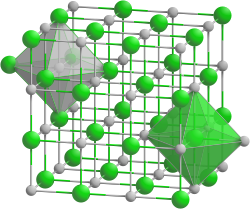 | |
 | |
 | |
| Names | |
|---|---|
| Preferred IUPAC name Lithium chloride | |
| Systematic IUPAC name Lithium(1+) chloride | |
| Identifiers | |
3D model (JSmol) | |
| ChEBI | |
| ChEMBL | |
| ChemSpider | |
| ECHA InfoCard | 100.028.375 |
| EC Number |
|
| MeSH | Lithium+chloride |
PubChem CID | |
| RTECS number |
|
| UNII | |
| UN number | 2056 |
CompTox Dashboard (EPA) | |
| |
| |
| Properties | |
| LiCl | |
| Molar mass | 42.39 g·mol−1 |
| Appearance | white solid hygroscopic, sharp |
| Density | 2.068 g/cm3 |
| Melting point | 605–614 °C (1,121–1,137 °F; 878–887 K) |
| Boiling point | 1,382 °C (2,520 °F; 1,655 K) |
| 68.29 g/100 mL (0 °C) 74.48 g/100 mL (10 °C) 84.25 g/100 mL (25 °C) 88.7 g/100 mL (40 °C) 123.44 g/100 mL (100 °C) [1] | |
| Solubility | soluble in hydrazine, methylformamide, butanol, selenium(IV) oxychloride, 1-propanol [1] |
| Solubility in methanol | 45.2 g/100 g (0 °C) 43.8 g/100 g (20 °C) 42.36 g/100 g (25 °C) [2] 44.6 g/100 g (60 °C) [1] |
| Solubility in ethanol | 14.42 g/100 g (0 °C) 24.28 g/100 g (20 °C) 25.1 g/100 g (30 °C) 23.46 g/100 g (60 °C) [2] |
| Solubility in formic acid | 26.6 g/100 g (18 °C) 27.5 g/100 g (25 °C) [1] |
| Solubility in acetone | 1.2 g/100 g (20 °C) 0.83 g/100 g (25 °C) 0.61 g/100 g (50 °C) [1] |
| Solubility in liquid ammonia | 0.54 g/100 g (−34 °C) [1] 3.02 g/100 g (25 °C) |
| Vapor pressure | 1 torr (785 °C) 10 torr (934 °C) 100 torr (1130 °C) [1] |
| −24.3·10−6 cm3/mol | |
Refractive index (nD) | 1.662 (24 °C) |
| Viscosity | 0.87 cP (807 °C) [1] |
| Structure | |
| Octahedral | |
| Linear (gas) | |
| 7.13 D (gas) | |
| Thermochemistry | |
Heat capacity (C) | 48.03 J/mol·K [1] |
Std molar entropy (S⦵298) | 59.31 J/mol·K [1] |
Std enthalpy of formation (ΔfH⦵298) | −408.27 kJ/mol [1] |
Gibbs free energy (ΔfG⦵) | −384 kJ/mol [1] |
| Pharmacology | |
| V04CX11 ( WHO ) | |
| Hazards | |
| GHS labelling: | |
 [3] [3] | |
| Warning | |
| H302, H315, H319, H335 [3] | |
| P261, P305+P351+P338 [3] | |
| NFPA 704 (fire diamond) | |
| Flash point | Non-flammable |
| Lethal dose or concentration (LD, LC): | |
LD50 (median dose) | 526 mg/kg (oral, rat) [4] |
| Safety data sheet (SDS) | ICSC 0711 |
| Related compounds | |
Other anions | Lithium fluoride Lithium bromide Lithium iodide Lithium astatide |
Other cations | Sodium chloride Potassium chloride Rubidium chloride Caesium chloride Francium chloride |
| Supplementary data page | |
| Lithium chloride (data page) | |
Except where otherwise noted, data are given for materials in their standard state (at 25 °C [77 °F], 100 kPa). | |
Lithium chloride is a chemical compound with the formula Li Cl. The salt is a typical ionic compound (with certain covalent characteristics), although the small size of the Li+ ion gives rise to properties not seen for other alkali metal chlorides, such as extraordinary solubility in polar solvents (83.05 g/100 mL of water at 20 °C) and its hygroscopic properties. [5]

